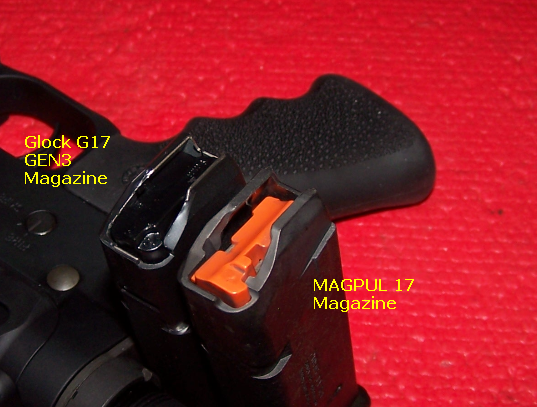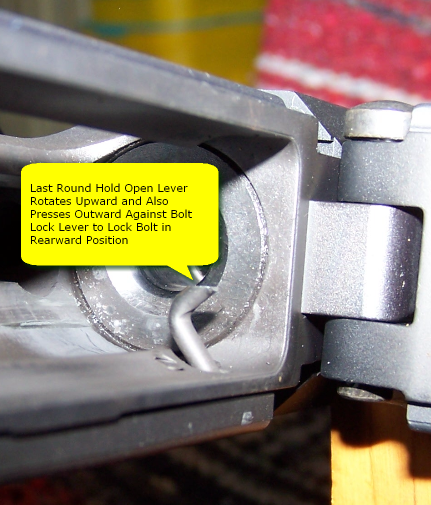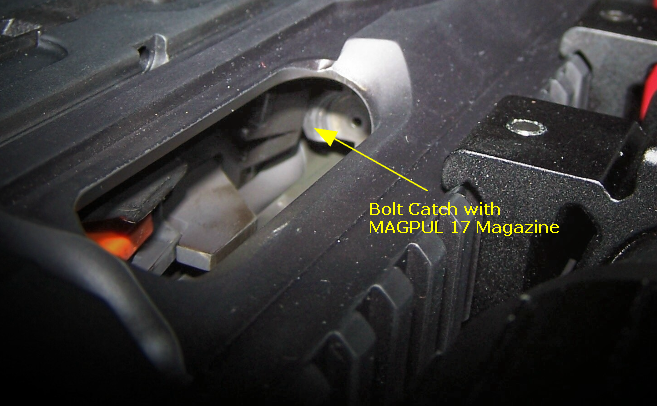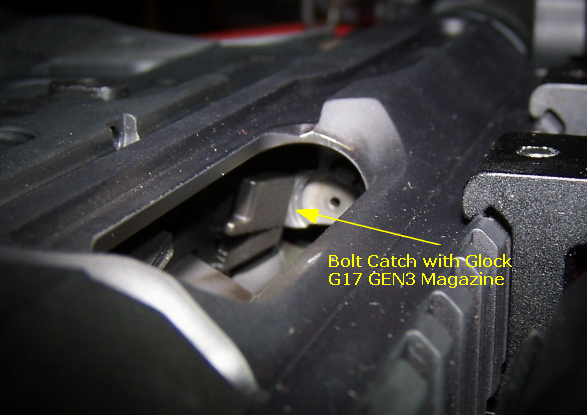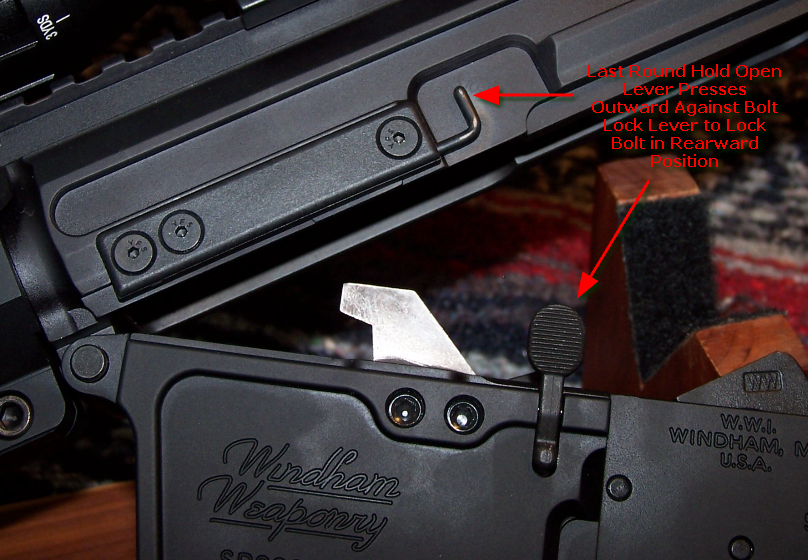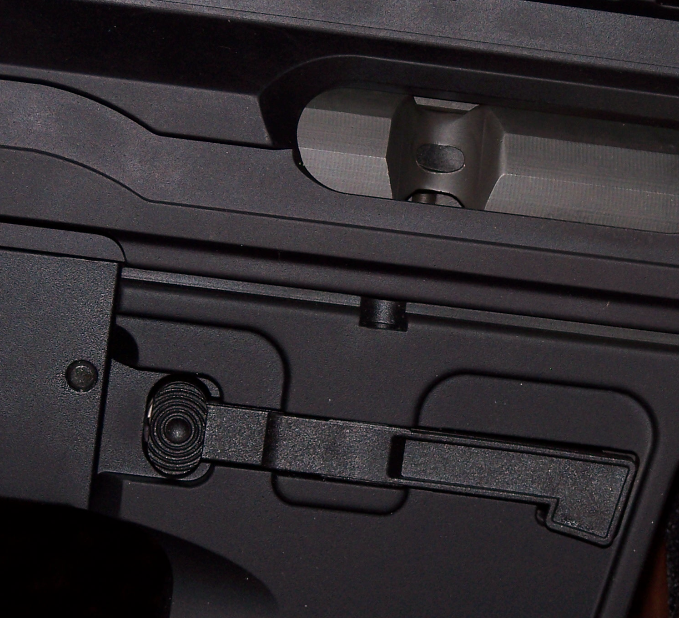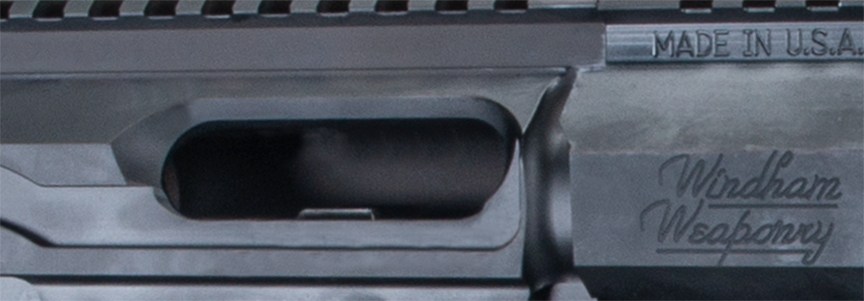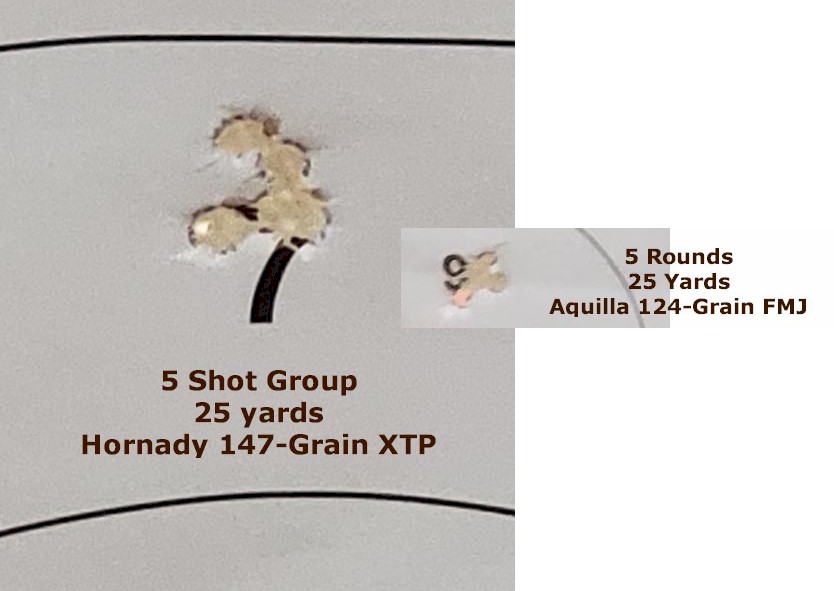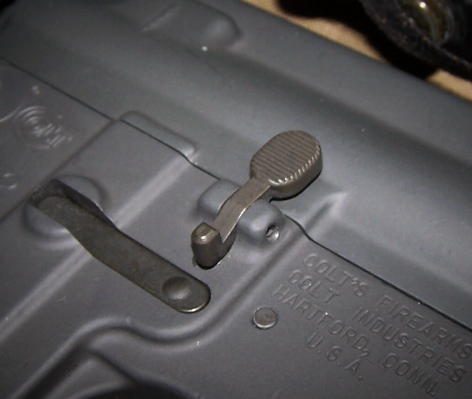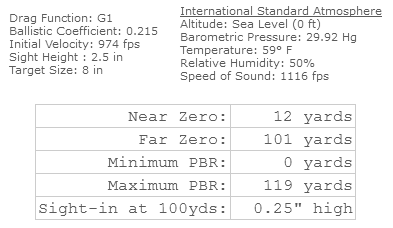I recently read several article regarding the top PCCs (Pistol Caliber Carbines). The usual beasts were there; H&K, Sig Sauer, CZ, Kel-Tec, Beretta CX4 Storm, CMMG, Ruger, and even the Hi-Point were among those listed.
Of those listed above, I am personally familiar with the Beretta CX4 Storm, which when paired up with a Beretta Model 92 makes an excellent combination since they both use the same magazines. Recently, Sturm Ruger introduced its PC Carbine that uses Ruger SR magazines, but can be modified to use Glock magazines (the magazine release button must remain on the left side to use older Glock magazines).
I am also personally familiar with Hi-Point Carbines (.45 ACP and 9mm). Hi-Point, while many snub their noses at Hi-Point pistols, would be surprised to find that Hi-Point PCCs are very different animals. Firing Hi-Point PCCs in 9mm and .45 ACP quickly reveals that these PCCs are worthy of ownership.
If a Hi-Point PCC can make a list of top 10 PCCs, why I asked, would not a Windham Weaponry WW R16FTT-9mm? I am sure that if Glock would come out with a PCC that it would be at the top of the list simply because, well, it would be a Glock. Windham Weaponry (formally Bushmaster) has been around the block and they know what they are doing when building “Stoner-based” firearms. I would expect that they would know what they are doing when building a “Stoner-based” PCC.
It is always a good feeling that a firearm that you own makes the top 10 list. There is a lot of competition in firearm’s manufacturing where nearly everybody comes out with new products that, they hope, will take the industry by storm.
I read another “Top” article. This time, it was the top fifteen! And, a Chiappa M1-9 Carbine made that list. Even a Henry carbine made that list along with Rock River Arms, Colt, Kris Vector, and JP Rifles. But, nope! There was no sign of a Windham Weaponry. I felt a need to rectify that, or at least have a hand in doing so. However, to have at least a hand in wanting to see the Windham Weaponry WW R16FTT-9mm hit a top 10 list, or any list for that matter, I needed to check one out so that I could respond to some of these “List Makers” and ask why they passed up an excellent choice in a PCC?
I leafed through my Windham Weaponry catalog and did not find a WW R16FTT-9mm listed. I did find it online at the Windham Weaponry website along with the Windham Weaponry 9mm MCS, the R16FTM that uses a 20 round Colt magazine. What intrigued me was that the WW R16FTT-9mm uses Glock magazines. And, since I have a few Glock pistols in 9mm well…
Doing some research, I found nothing on the WW R16FTT-9mm. And, I do mean nothing. No reviews, written or otherwise could be found aside from promotional literature. It was like the WW R16FTT-9mm didn’t exist. The WW R16FTT-9mm is comparably priced between high-end and low-end PCCs. My interest was peaked even more. I needed to find out why the WW R16FTT-9mm, or the Windham Weaponry 9mm MCS for that matter, had so very little information about them except from Windham Weaponry.
If you have followed my ramblings you would know that I have written several reviews on Windham Weaponry MSRs; the Model R16M4FTT in .223 Remington/5.56mm NATO, the Model R16M4FTT-762 in 7.62 x 39mm, and the Model R20FFTM-308 in .308 Win. All are quality MSRs built by quality people who really care about the products they send out the door.
Now, I am not a well-known reviewer of firearms by any means and I don’t do videos. I simply say what I think and feel about a firearm that I have had the opportunity to experience and render an honest opinion so that others can at least think about the firearm I have reviewed, and make an educated decision regarding if it is a firearm they would like to own. It would be dishonorable of me to write about something I don’t know, express my opinion, and then expect you to accept my word.
I sent an e-mail to Matt Hasty, who is the Sales & Marketing Project Manager at Windham Weaponry. Matt had helped me get the Windham Weaponry Model R20FFTM-308 in .308 Winchester as a T&E firearm, which I fell in love with and ended up purchasing. Anyway, I was again honored to receive a response from Matt to the affirmative of receiving a Windham Weaponry WW R16FTT-9mm PCC for test and evaluation; a review of which you are about to read.
The first thing that you will realize when you receive a Windham Weaponry firearm is that it comes in a hard case and not some cardboard shipping container that soon resides in a re-cycle bin. The case is fully padded. There nestled along with the firearm in a re-sealable bag is a sling, one PMAG 17 GEN 5-type magazine, a Windham Weaponry full-color catalog, and an Operation and Safety Manual, which you should read even though it does not cover the R16FTT-9mm carbine specifically. (As one who writes technically by trade, I can tell you that there is nothing worse than writing good material and nobody reading it. It makes the writer feel that they should be doing something more useful; like refereeing a volleyball match at a nudist colony.) The owner’s manual is one of the best that I have read with full color illustrations and a plethora of precise prose that you can actually understand. I don’t know who writes their owner’s manuals, but I thank them.
Picking up the 6.7 pound, 34.5″ (876.3mm) / 30.75″ (781.05mm with Telestock Collapsed) WW R16FTT-9mm from the case, the WW R16FTT-9mm looks like any other MSR on the market at first glance. If you currently own a MSR there is an immediate familiarity with the WW R16FTT-9mm. I discovered that at 6.7 pounds, the WW R16FTT-9mm is actually heavier than the R16M4FTT in .223/5.56 NATO by several ounces. Recoil? We don’ need no stinkin’ recoil!
The receiver is Billet 7075 T6 Aircraft Aluminum with Integral Trigger Guard with a Hard coat Black Anodize Finish. All controls are the same as any other MSR and in the same place. Although the WW R16FTT-9mm uses Glock magazines, the magazine release is still on the right side. The safety lever is standard with standard markings on both side of the receiver. In short, everything is where you expect it to be.
One major difference between the lower of the WW R16FTT-9mm and standard MSR lowers is the magazine adapter. The R16FFT-9mm has a magazine well for use with Glock 26, 19, and 17 magazines from GEN5 and earlier. This magazine adapter is not an adapter; it is integrated into the design of the lower.
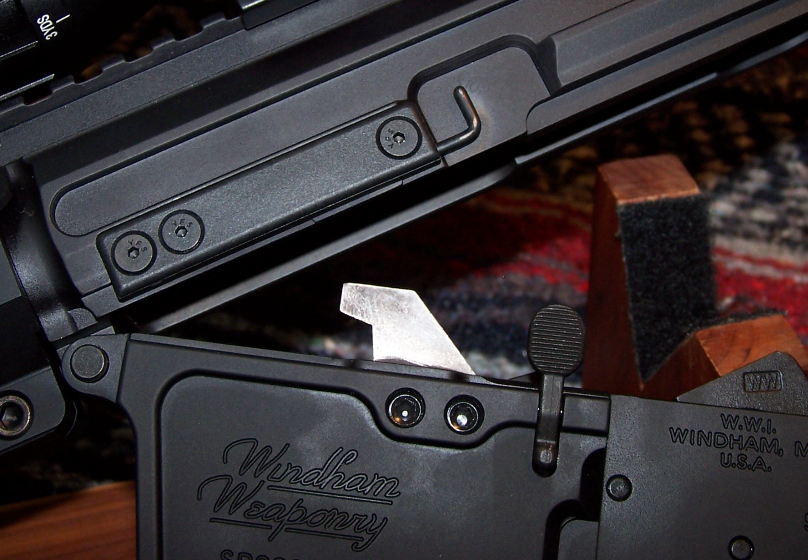
Positive Ejection!
In the picture above, you will notice two screws on the left side of the receiver. These screws hold the Ejector in place, since there are obvious differences between Glock magazines and standard AR magazines and the ejector had to be located somewhere different.. The massive ejector also serves to prevent magazine over-travel when inserting a magazine. Magazine release and locking functions are all right-sided. I do have to say that it is somewhat strange to press a thin magazine into a MSR receiver. However, magazines lock and drop like they are supposed to.
Another major difference is a small plate that reside on the left side of the lower. Within this small plate is a bent metal rod that contacts the bolt catch and the feed lip of the Glock magazine. This, in effect, is the bolt hold-open-on-last-round feature. When the magazine follower contacts the hold-open assembly the bolt catch is forced outward, this effectively locks the bolt to the rear. When a freshly-loaded magazine is inserted and locked into place, and If you push the Bolt Catch pad inward as you normally would, the bolt is released.
And Then an Issue Came Up!
The bolt; however, would close with an empty magazine properly inserted. But, that needs to be explained, because it is not the fault of the firearm, but rather of the provided magazine.
The WW R16FTT 9mm ships with one PMAG 17. From the picture below, you can see obvious differences between the PMAG 17 and a standard Glock G17 magazine. But, I need to step into this in order to explain what, I believe, is happening.
After the last round is fired, the magazine follower presses against the Last Round Hold Open Lever, which rotates upward and cause the other end of the Last Round Hold Open Lever to press outward against the Bolt Catch lever, which is under spring tension, and which causes the Bolt Catch to move upward against the face of the bolt when it moves inward, which locks the bolt in place.
With the PMAG 17 magazine, the Bolt Catch was only partially catching the bolt face (as shown in the second figure above). A hard slap on the side of the receiver would release the bolt, and sometimes it only took a light slap on the receiver to release the bolt, and sometimes simply inserting a magazine would cause the bolt to close. It was time to do some troubleshooting.
I had three standard Glock G17 magazines. With each of these magazines, pulling the bolt to the rear with an empty Glock G17 magazine set the Bolt Catch fully on the bolt face. No manner of slapping the side of the receiver would close the bolt. It was time to compare magazines.
With a digital caliper in hand I measured from the top of the magazine catch to the top of the portion of the magazine follower that presses against the Hold Open Lever (in a Glock pistol that would be the Slide Lock Lever). The PMAG 17 measured 1.2475 inches; whereas, the Glock G17 magazine measured 1.2955 inches. Now that doesn’t seem like a lot, but a little can make a big difference. There are also differences in magazine spring tensions, and I do not have the tool to measure that, but it can be felt.
Considering that the Bolt Catch is under spring pressure, the outward force of the Hold Open Lever must overcome the Bolt Catch spring tension sufficiently enough to force the Bolt Catch to catch the bolt face completely. Given a combination of weak (magazine) spring pressure, and the Hold Open Lever not being able to fully push the Bolt Catch out far enough (due to the shorter magazine follower engagement with the opposite end of the ‘Last Round Hold Open Lever), the bolt is not locked back sufficiently enough to disregard a slap on the side of the receiver, or when inserting a fresh magazine when I used the PMAG 17 magazine.
At this point, I highly recommend using standard Glock G17 magazines, as most would, in the WW R16FTT-9mm carbine to ensure complete and reliable bolt hold open capabilities. (It is not uncommon for us to substitute a provided magazine with our own favorite.) I used an array of Glock magazines from the Glock G26, G19, and G17 and all performed without failure. To give the PMAG 17 magazine a fair shake, it did perform without fail in the Glock G26, G19, and G17 pistols.
Is a premature bolt release a safety issue? No, I do not believe so, because bolts are closed on loaded magazines very, very frequently without the chambered round going off. While a standard MSR has a floating firing pin, the WW R16FTT-9mm carbine has a spring-loaded firing pin. Neither of which has enough forward momentum when a bolt closes to prematurely detonate a primer. Premature bolt closure; however, may bother some.
Back to our Regularly Scheduled Program
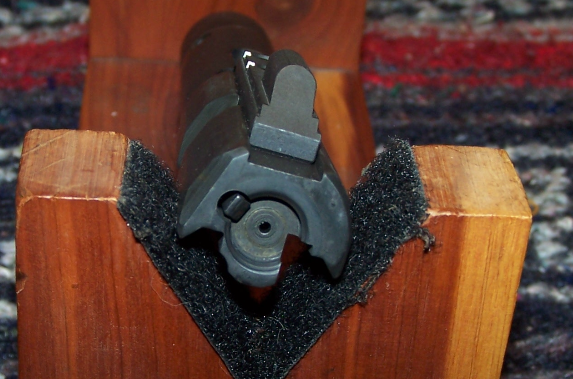
9mm Bolt (Slot at Right is for the Ejector)
The bolt face and chamber feed is also entirely different from what you would see in a standard MSR. A standard MSR’s bolt rotates into place; the bolt of the 9mm carbine does not rotate. The chamber mouth is beveled to allow for smooth feeding; the mouth of the cartridge case will not catch on the mouth of the chamber. As normal, the 9mm cartridge is head-spaced on the mouth of the case. The web of the cartridge case; however, does not seem to be fully supported. Whether that is cause for concern, I don’t know at this time. What I can say is that blow-back operation means that everything, well, blows back. And, since I am a left hand operator, my face is on the same side from which everything blows back. I’ll address this later during the range day section of this article.
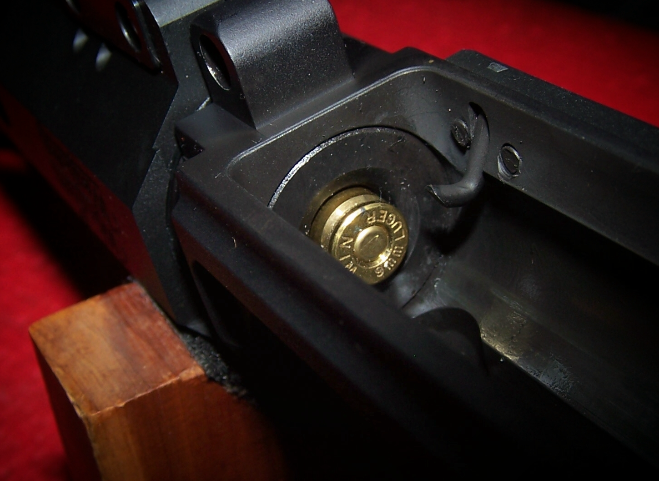
Fully-Chambered Cardtidge
The bolt’s internal extractor is part of the bolt face and slides over the rim of the cartridge as it’s supposed to, and extracts the spent cartridge very well, thank you.
The upper attaches to the lower just like a “real” MSR with pins fore and aft. The upper incorporates a MIL-STD “Picatinny” rail which blends in perfect with the Windham Weaponry 13″ (330.2mm) Free-Floating Hand Guard with 2” (50.8mm) Rail Section on each forward end. The forend is M-Lock compatible for mounting stuff. The forend is also highly ventilated to allow heat to dissipate from the barrel while dissuading zombies from eating me as I place jacketed projectiles into their deceased brains. The ventilated forearm also warms my support hand on a cold winter’s day. Or, with the right set of side mounts, I might be able to heat up a couple of Slim Jim snacks.
And, speaking of heating Slim Jim snacks, the profile of the barrel (shown below) is quite fascinating, which has absolutely nothing to do with eating Slim Jim snacks.
The WW R16FTT-9mm lends itself to sights such as Magpul MBUS, or any other sights that set my heart aflutter, which includes optics. Essentially, the WW R16FTT-9mm is a SRC (Sight Ready Carbine) that seems to appeal to a lot of people, including me, who like their own choice of sighting options.
At the rear of the upper, where normally resides a charging handle, resides a charging handle.
Looking at the right side of the upper, an ejection port is in its usual place. No dust cover is provided, nor is a shell deflector. Actually, no shell deflector is needed, as ejection is straight to the side and not to the rear. (The majority of us “lefty shooters’ really appreciate a shell deflector feature at times when shooting rifle caliber ammunition from a MSR.) The other thing that is absent is a “forward Assist” button, as none is needed with PC ammunition.
The bolt (shown below) is 8620 steel and houses the spring-loaded firing pin and extractor.

Bolt Carrier
The integrated bolt/bolt carrier is driven rearward by simple blow-back action and then pushed forward into battery by the buffer spring. Lock-up seem positive as a fresh round is stripped from the provided magazine (and also a Glock 17 magazine). The bolt carrier is NOT the same as on any WW MSR; “This 9mm Caliber Blow-back System Bolt Carrier is necessary for proper functioning with 9mm Ammunition in our WindhamWeaponryAR platform Multi-Caliber system. Unlike the two separate components of the standard .223 Bolt and Bolt Carrier, this 9mm unit is one solid assembly. It includes a firing pin and the staked on guide piece on top. It should be used with our heavy 9mm Buffer.” Source: Windham Weaponry. The firing pin is not free-floating, by the way. The firing pin is under spring tension, which means that the firing pin should be held in place (or pushed to the front) while the Firing Pin Retaining Pin is removed. The Firing Pin Retaining Pin is the same pin type used on other MSRs. Hold the firing pin in with the thumb or finger (whichever fits), remove the Firing Pin Retaining Pin, and then slowly allow the firing pin to slide rearward out of the bolt.
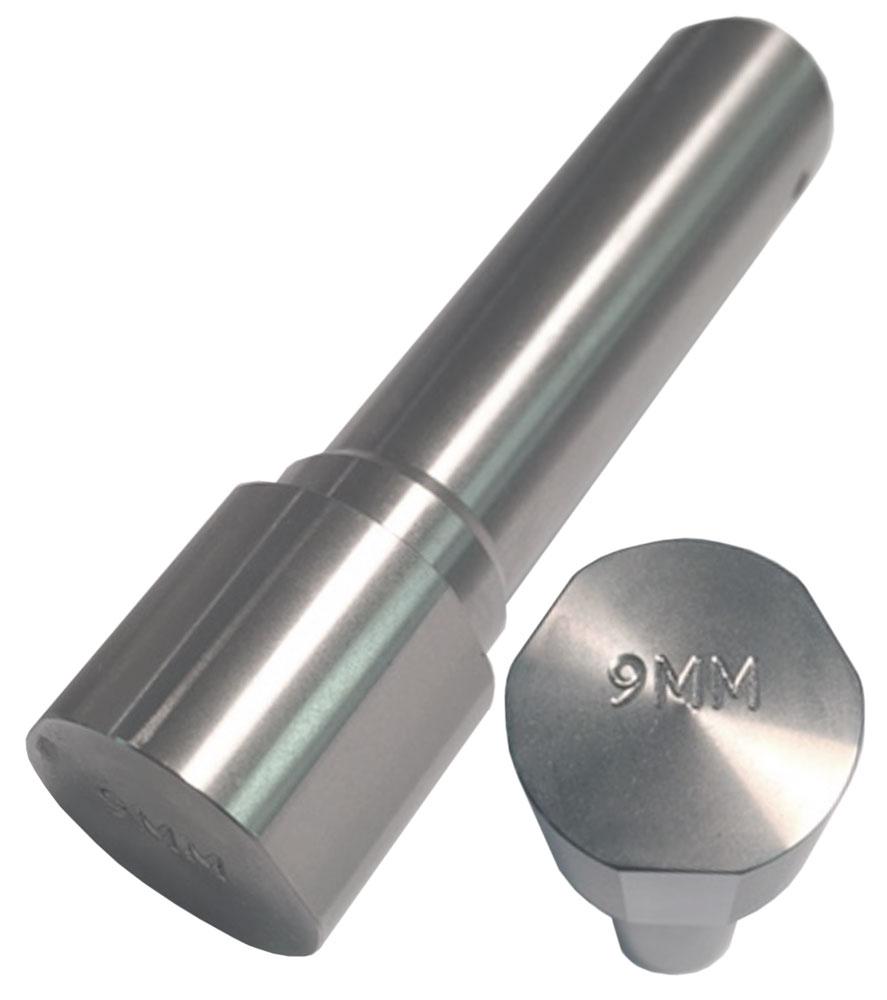
The R16FTT-9mm Buffer
The buffer is NOT the same as found on a standard .223/556 NATO MSR. “For enhanced and noticeably smoother operation of the Windham Weaponry MCS System in 9MM caliber mode, this new, upgraded 9mm buffer offers several side benefits: smoother function, less felt recoil, increased reliability, more consistent cycling, and a reduced rate of fire. While we recommend this buffer for our Multi-Caliber System, it will improve the function of any AR platform 9mm rifle. The buffer installs the same as any regular AR-15 buffer. It is machined from high quality stainless steel and utilizes standard AR-15 H2 buffer internals. To help with identification while installed, the face has been stamped 9mm. Weight is 8.4 oz.” – source: Windham Weaponry.
If were sharp enough, you may have caught the “…reduced rate of fire” statement. I am hoping that this was a misprint, because I am looking for: “…smoother function, less felt recoil, increased reliability, more consistent cycling, and an increased rate of fire.” (Author’s Note: The WW R16FTT-9mm Carbine is capable of providing a controllable high-rate of fire.)
The WW R16FTT-9mm comes with a standard A2 plastic pistol grip that is common to a lot of MSRs. (See also, Updates)
To make different shooters happy, a 6-Position Telescoping Butt Stock is provided. Like most other telescoping stocks, squeezing the release/lock lever allow one to adjust to their particular needs. And, as with most telescoping stocks, there is a bit of side play. A rear sling mount is provided, as is a front QD sling mount on the forward left-side of the forearm. Being a ‘lefty’ operator, I would probably have another one mounted on the right side to accommodate left-side carry. If I decide to keep the firearm, I will probably try to find a carbine-length fixed stock, as I prefer a fixed stock to a ‘Telestock’.
At this point in the review, sans the initial bolt issue of not locking back sufficiently, which was corrected by using a standard Glock G17 magazine, my overall impression of the WW R16FTT-9mm is highly favorable. Range results would help me decide the rest.
First of all was thoroughly going over the firearm and ensuring that it was properly lubricated. Lubrication is applied to the same bolt/bolt carrier contact surfaces you would find in standard Modern Sporting Rifles. Windham Weaponry recommends CLP. Like any MSR, the bolt should be run “wet.”
Range Days
Since the WW R16FTT-9mm is a SRC, my choices of sights were what I had on hand. You see, dots are not dots with my eyesight and astigmatism. I am really a cross-hair kind of guy and I happened to have a Leapers UTG Compact CQB Rifle Scope 4x32mm Adjustable Objective 36 Color Illuminated Mil Dot Reticle Matte (shown below) that was left over from a previous MSR build.
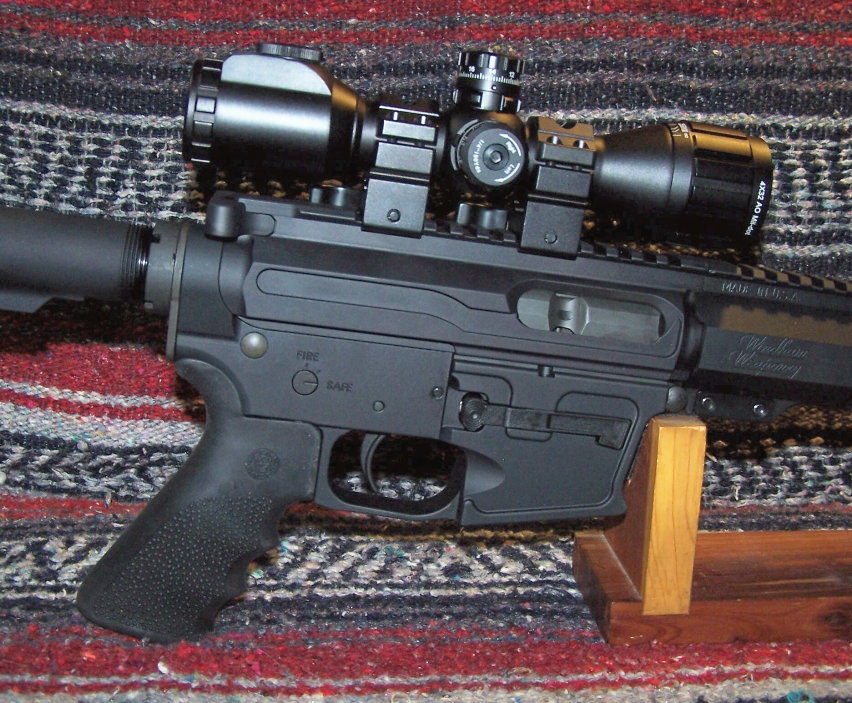
Leapers UTG Compact CQB Rifle Scope 4x32mm Adjustable Objective 36 Color Illuminated Mil Dot Reticle Matte
The Leapers UTG Compact CQB Rifle Scope 4x32mm Adjustable Objective 36 Color Illuminated Mil Dot Reticle Matte has features like; 1-Inch tube construction, 100-Percent waterproof and fog-proof with extra rigid shockproof construction, multi-Coated optics for clear crisp images with illuminated red and green mil-dot reticles, and easy-grip target-style windage and elevation adjustments, an adjustable objective lens, and infinite parallax. 1/4 MOA click adjustment makes this scope precise and easy to use in tactical environments. The scope adds 1.25 pounds to the weight of the WW R16FTT-9mm (6.7 lbs.).
I had a few G17 magazines at my disposal along with Aguilla 124-grain FMJ, Federal 115-grain FMJ (White Box), and I threw in some Sig Sauer V-Crown 147-grain JHP, Speer 124-grain GDHP, and Hornady Custom 147-grain XTP just to see how the WW R16FTT-9mm would run with some serious defensive ammunition.
The trigger is your run-of-the-mil MIL-SPEC trigger, which means that it is supposed to be rough and have a heavy pull weight. The trigger of the WW R16FTT-9mm, while somewhat heavy in pull weight (7 pounds average), is relatively smooth with little take-up and over-travel. With that said, the WW R16FTT-9mm is not a target rifle and for this T&E piece, the trigger was good enough for my purposes for the first time. The trigger will smooth out over time and use. If I decide to keep the WW R16FTT-9mm, I honestly doubt that I will touch the trigger…but I could talk myself into doing so.
With the WW R16FTT-9mm in hand, I decided that a distance of twenty-five yards would be suitable for this first test run, which is a good decision seeing that I only have twenty-five yards to work with at my local gun club and range.
First up was bench resting for function and accuracy. After that, it was time for some off-hand work.
The Leapers UTG Compact CQB Rifle Scope 4x32mm Adjustable Objective 36 Color Illuminated Mil Dot Reticle Matte dialed right on in with the majority of adjustment leaning to the elevation.
The WW R16FTT-9mm was new and I did not expect it to run perfectly the first time out, but it did.
The pictures below are two of my best five-round, bench rested, group at twenty-five yards with Hornady 147-grain XTP ammunition and Aguilla 124-grain FMJ. Offhand, I would say that the WW R16FTT-9mm is pretty darn accurate, and precision is not bad either considering my getting used to a new trigger, which began smoothing out after about thirty rounds.
The WW R16FTT-9mm seemed to like the Hornady 147-grain XTP ammunition and would be a viable choice for self-defense.
I ran, primarily, Glock GEN3 and GEN4 magazines with no issues locking back the bolt on the last round fired. To be fair in my evaluation, I also shot with the provided PMAG 17 magazine. There were no failures of the bolt locking back on the last round, but the premature bolt release issue was still present. I’ll continue to run Glock G17 magazines, thank you.
Releasing the bolt using the Bolt Catch Lever is not a problem; very little pressure from my trigger finger did the job every time (since I am a ‘lefty’ shooter, I use my trigger finger to release the bolt). Locking the bolt back using the Bolt Catch is still an ‘iffy’ issue for me, as I have to reach around with my right hand to pull the Charging Handle to the rear while using my left hand to press the Bolt Catch lever. I have never cared for the Bolt Catch design on any standard MSR; the small nub that is supposed to be used for locking the bolt after retracting the Charging Handle has never caught my fancy, and I have always felt that a larger ‘nub’ is needed. For my fingers, there is simply not enough nub.
There were absolutely no malfunctions. Ejection was straight out to the right, which might be disconcerting to the person on the right, but my previous worry about ejection angle turned out to be not worth the worry.
Although I need to mention it, recoil is not even worth mentioning.
I have not experienced any failures with the R16FTT-9mm carbine, with the exception of not locking back sufficiently when using the provided PMAG 17 magazine. With that said, and with about a dozen Glock G17 magazines, and a couple of Glock G26 and Glock G19 magazines being run through the R16FTT-9mm carbine, no lock-back issues have occurred.
As far as accuracy goes, the accuracy of the Windham Weaponry R16FTT-9mm carbine is pretty darn good. So far, my best grouping is 1” at twenty-five yards with ten shots while “standing and delivering” with the stock trigger. And, that was with Aguilla 115-grain FMJ, with what started out as a head shot and trying to put the other nine in the first hole. The Windham Weaponry R16FTT-9mm carbine is quite capable of excellent accuracy if you do your part.
Spare Parts
It should be obvious that when you are working with a firearm that is “out of the norm” the question of spare parts availability would come to mind. In the case of the WW R16FTT-9mm, spare parts availability questions can be answered easily.
Unless you change out the trigger, trigger parts are standard Mil Spec and are readily available.
Magazines are not an issue, as Glock magazines are plentiful.
The bolt/bolt carrier is different from any found in an MSR. The buffer is also different. Otherwise, everything within the receiver is the same; trigger group, detents, pivot and takedown pins, etc. Spare bolt carrier and buffer tube is available from Windham Weaponry’s on-line store. If you keep the stock trigger, a field repair kit of various springs and things might not be a bad idea; All of which are available through Windham Weaponry.
A spare firing pin spring might be handy, as this would be prone to loss if the firing pin is not removed correctly.
Upgrades
Even before the first range day, I started thinking about personal upgrades, even though this was a T&E firearm and I had no claim to ownership of it. That’s just the way I am. While an optic was a necessity, the A2-style hand grip was exchanged for my favorite Hogue Rubber finger-groove grip, which provides a little more surface area for my hand to grip. Also, a MAGPUL FG2 angled fore grip was added. Let’s face it; there is always the possibility that a firearm may undergo changes according to person’s wants, desires, and/or necessities.
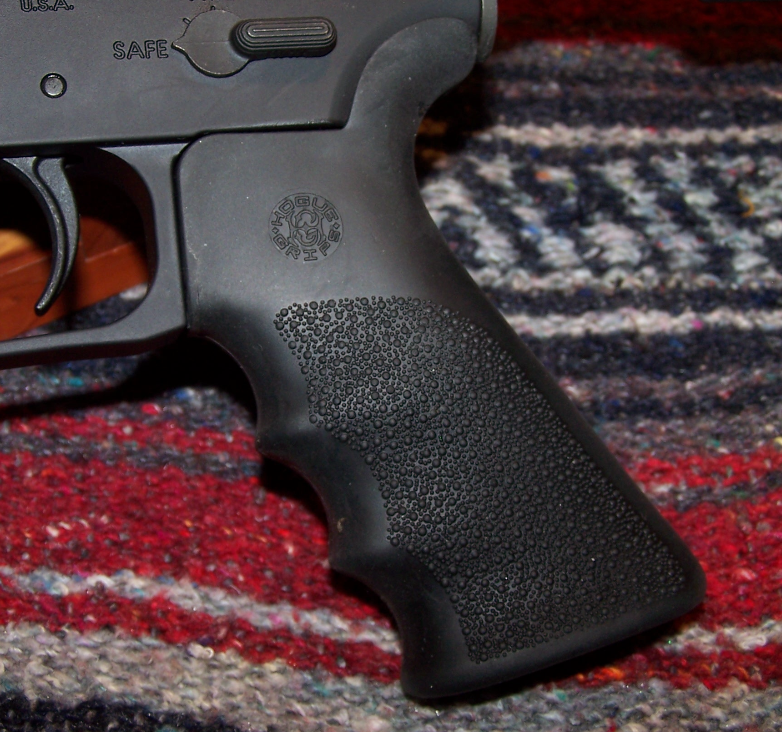
Hogue Rubber finger-groove grip
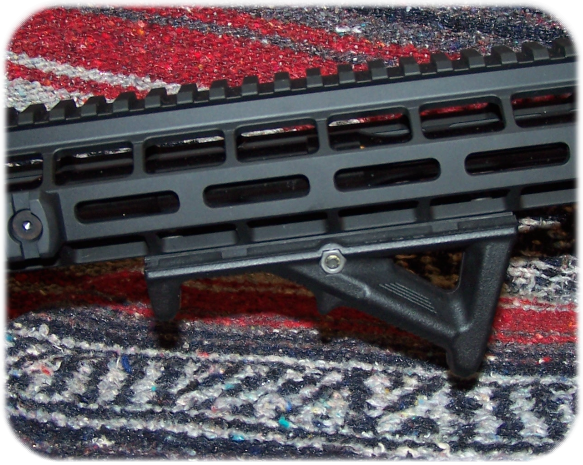
MAGPUL FG2 Angled Fore Grip
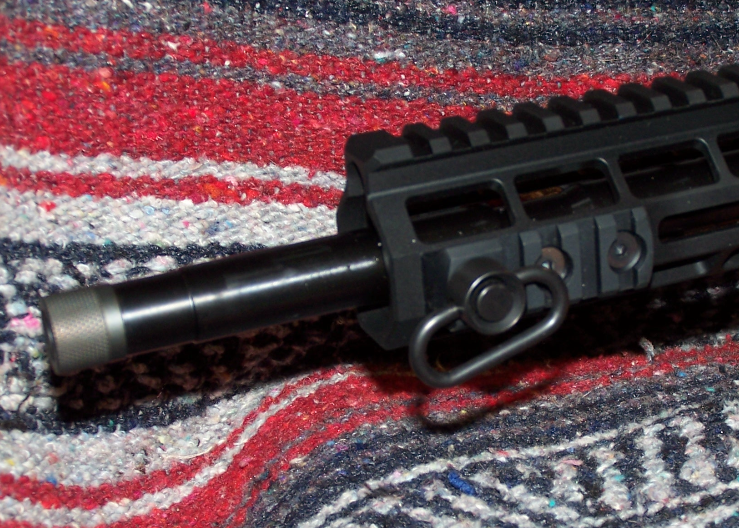
16″ Fully-Threaded (1/2″ x 28) Barrel
The almost several hundred FPS increase of the 9mm cartridge when fired out of a 16” barrel over that fired through a 4.6” barrel. (The R16FTT-9mm carbine’s barrel is 16″ (406.4mm) barrel and has a Melonite QPQ Finish with 1/2″ x 28 T.P.I Thread Protector – it is “can” ready. Rifling is 1 in 10″ (254mm) with a Right Hand Twist.) Even with ammunition intended for short barreled firearms, means that the effective range of the 9mm has increased. The MPBR [maximum Point Blank Range] for the Hornady 147-grain XTP ammunition is shown below. Of course, a faster, lighter projectile would result in a different MPBR and I did not take in account the increased velocity of the round out of a 16” barrel, but I don’t perceive a large difference. Of course, this is all speculation until tried and trued.
While intended for short distances, the 9mm cartridge has a substantial gain at longer distances with the 16-inch barrel that, to me, means an optic that can be used at short as well as longer distances. I am a cross-hair guy and that means a good scope is in order; one like the Leapers UTG Compact CQB Rifle Scope 4x32mm Adjustable Objective 36 Color Illuminated Mil Dot Reticle Matte fits the bill very nicely for distances from 10 yards (the minimum that I would use it) through twenty-five yards and beyond (depending on the size of the target).
However, with the third range day under my belt, I decided to change the scope. I had mounted a Nikon P223 3x32mm scope on a Ruger PC Carbine and really liked it, as the clarity of the scope outweighed that of the Leapers UTG Compact CQB Rifle Scope 4x32mm Adjustable Objective 36 Color Illuminated Mil Dot Reticle Matte scope. Due to the configuration of a ‘Stoner” based carbine, a set of Warne 1” High QD scope rings was ordered along with the Nikon P223 3x32mm scope; the medium rings used for the Ruger PC Carbine, in my opinion, were too low given the difference in stock designs of the two carbines.

Nikon P223 3x32mm Scope

Warne MAXIMA 1″ High QD Scope Rings
Finally, I opted to change the trigger to a much better one, the Hiperfire EDT (Enhanced Duty Trigger®) DM (Designated Marksman) for AR15 / M16 & AR10 Rifles. This swap has made a substantial difference in trigger action and control.
Final Impression
I really did not know what to expect from the Windham Weaponry WW R16FTT-9mm PCC. There was no real background information on it. I was a little reluctant to be the first, but somebody has to be. And, since I am always late in the game of reviewing firearms, this was a nice chance to be first for a change (or so I am claiming).
As I mentioned in the beginning of this article, if you are used to the “Stoner-based platform,” the WW R16FTT-9mm PCC will become familiar to you in a very short time. Mated with a Glock G19, G17, G26, G34, or G17L, you would have a formidable combination for defending self or home, and magazines for those firearms are highly available and compatible with the WW R16FTT-9mm PCC .
All Windham Weaponry firearms are made in the U.S. of America and have a fully-transferable lifetime warranty. Customer service is excellent and WW is happy to answer any questions that might be asked of them relating to a firearm. Do not; however, expect an answer to the best Slim Jim snack holder for your MSR.
If the “standard” model does not fit your fancy, Windham Weaponry will build your firearm to your specifications.
The WW R16FTT-9mm carbine, as is the Windham Weaponry 9mm MCS (Model: R16FTM-9MM), is available to both law enforcement and civilian folks.
The PCC is an excellent choice for home defense and has many advantages over a shotgun and, possibly, a MSR of more substantial caliber. The PCC is easier to learn to use well than a full-power rifle. A PCC has less muzzle blast than a shotgun or high-powered rifle or carbine, and is easier to handle and get into action. Plus, if your PCC and PPP (Personal Protection Pistol) are chambered in the same caliber and use the same magazines, that is a definite advantage.
If your top 3 firearms is a rifle, shotgun, and pistol, why not make it 4 and add a PCC to the mix. The WW R16FTT-9mm carbine has made it to the top of my personal list of PCCs, and I would really like it to make its mark in the broader list of PCCs, if not make it to the top for cost vs. quality. In the case of the WW R16FTT-9mm carbine, the price of admission is definitely worth the show.
My impression of the Windham Weaponry R16FTT is favorable enough to own one, and arrangements were made to do just that.
Resources
Note: I have provided resources that provide you with base information and shopping options. Use your consumer research competency to find the best prices.
- Windham Weaponry WW R16FTT-9mm: https://www.windhamweaponry.com/firearms/rifles/windham-weaponry-9mm-carbine/
- Magpul AFG-2 Angled Fore grip: https://www.magpul.com/products/afg-2
- Magpul AFG-2 M-Lock Adapter: https://www.magpul.com/products/afg-2-m-lok-adapter-rail
- AR-15/M-16 Rubber Grip Beavertail with Finger Grooves Black: https://www.hogueinc.com/ar-15-m-16-rubber-grip-beavertail-with-finger-grooves-black
- Nikon P223 3x32mm Rifle Scope: https://www.nikonsportoptics.com/en/nikon-products/riflescopes/p-tactical-.223-3×32-bdc-carbine.html
- Warne 1” DQ High Scope Rings: https://warnescopemounts.com/product/202l-1-inch-quick-detach-high-rings/
- Hiperfire EDT DM Trigger: https://shop.windhamweaponry.com/product/8448592-edt3/ (See also: https://guntoters.com/blog/2019/03/09/hiperfire-edt-enhanced-duty-trigger-dm-designated-marksman-for-ar15-m16-ar10-rifles/).
Video Extras
Windham Weaponry 9mm rifle Promotional Video: https://vimeo.com/292187329
PCC Carbine for Self-Defense: http://blog.cheaperthandirt.com/pistol-caliber-carbines-home-defense/
Other Extras
Calculating MPBR: http://www.shooterscalculator.com/
![]()




